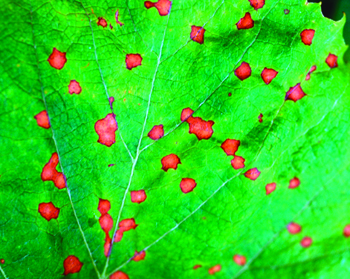Managing black rot on grapes
Check for black rot and focus on protecting the clusters from infection.
Black rot lesions have been seen on grape leaves in various locations and range from 1 to 5 mm in size. They can be recognized by the tiny black pimples (pycnidia) in a ring along the inner edge of the lesion. Temperatures in the high 70s and low 80s are perfect for black rot. At these temperatures, only six to seven hours of wetness are needed for infection. Black rot is a tricky disease because infections can remain latent, or invisible, for a long period of time, so you won’t know that you have the disease until is it too late to do anything about it. However, one can scout for the small, round leaf spots – a lot of black rot leaf lesions indicate high disease pressure from ascospore inoculum and also contribute to fruit infections. In a field with a history of black rot, old fruit cluster remnants left hanging in the trellis are major contributors to infection. Fruit infections can take place anytime from bloom onwards, but only become apparent sometime between bunch closure and veraison. The period from immediate pre-bloom through early fruit development is crucial to protect grapes against black rot infection.
The approach to black rot control now focuses primarily on protecting the clusters from infection. EBDC sprays applied earlier in the season for Phomopsis will also control black rot leaf infections, and therefore no sprays are recommended specifically for black rot on the foliage early in the season. In five years of trials in New York, good black rot control was achieved with one immediate pre-bloom and one to two post-bloom fungicide sprays. A second post-bloom application is strongly advised if black rot has been a problem in the vineyard the previous year, and should be considered prudent if wet weather is anticipated. During three years of fungicide trials in a ‘Concord’ vineyard in Fennville, just two post-bloom applications of SI fungicides (Rally, Elite) have provided very good control under high black rot pressure.
Sterol-inhibitor fungicides, such as Nova and Elite, continue to provide outstanding control of black rot and provide several days of post-infection activity. Currently there are various “generic” tebuconazole products on the market, like Orius and Tebuzol, that may be more cost-effective. When using SI fungicides on a post-infection schedule, use the highest label rates because post-infection activity is strongly rate-dependent, particularly when extended “kickback” activity is required. The strobilurin fungicides (Abound, Flint, Sovran, Pristine) and Revus Top are also excellent protectants, but provide only limited post-infection activity. Flint, Pristine, and Revus Top should not be used on Concord grapes because of potential phytotoxicity.

Black rot lesions on grape leaf.
Dr. Schilder's work is funded in part by MSU's AgBioResearch.



 Print
Print Email
Email



